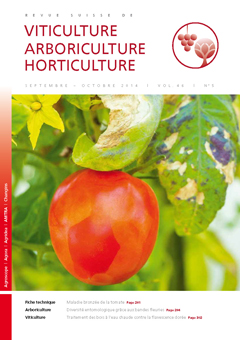
Issue 5 - September - October 2014

Abstract in open access
Floral strips help preservation of biodiversity which may be useful to reduce the threat of pest insects with beneficials. Two blends of flowering plants were tested: “wild” and “cultivated”. Every week (June to September 2013), the flowering degree of each species has been noted. Twice a week (in July and August), captures were realised with a sweep net. Cicadellidae and Coleopterae didn’t show any preference for one treatment. Cecidomyiidae, several Dipterae, Drosophilidae and parasitoid Hymenopterae were sensibly attracted by cultivated blend. Hemipterae and pollinators manifested a greater interest for the floral strips than to the control. This study reveals that the cultivated blend seems promising to enhance biodiversity, which should help to control pest with beneficial insects.
Keywords: biodiversity, floral strips, beneficial insects, apple orchard
E-Mail: dominique.fleury@changins.ch
Adress: School of Engineering at Changins
Abstract in open access
The genetic variability of Eutypa lata, the fungus responsible for Eutypa dieback of grapevine, in a single vineyard plot (Chasselas, Perroy) appeared very high based on ITS sequences obtained from 89 fungal isolates of this species. Thirteen different ITS genotypes were retrieved with three out of them not affiliated to E. lata sensu stricto after their placement in an ITS phylogenetic analysis that is representative of the Diatrypaceae family. This analysis also indicates that some of these genotypes are either exclusively associated with healthy plants or with diseased plants, while other genotypes are found associated indifferently with all studied plant types. These results suggest the possibility that only some E. lata strains with a particular genotype might be responsible for Eutypa dieback. A more thorough molecular characterization through sequencing and phylogenetic analyses of multiple genes for these isolates, as well as virulence tests, are needed to better understand the epidemiological significance of the genetic variability of E. lata observed.
Keywords: wood disease of grapevine, phylogeny, internal transcribed spacers (ITS), cryptic species
E-Mail: valerie.hofstetter"agroscope.admin.ch
Adress: Agroscope, 1260 Changins/Nyon
Abstract in open access
Hot-water treatment (HWT) is effective against the phytoplasms responsible for both flavescence dorée and grapevine bois noir. However, the temperature and duration of treatment employed present maximum values above which damage to the woody tissues of the vine can be detected. In particular, this leads to delays in budburst when the planting material is planted directly after HWT at 50 °C. Microscopic analyses of the conductive tissues and buds of three grape varieties (Vitis vinifera cv. Chasselas, Merlot and Cabernet Sauvignon) as well as hydraulic conductivity measurements were carried out after HWT at 50 °C. At the same time, an HWT test was conducted at 60 °C, well above the upper limit tolerated by the vine, in order to illustrate the damage to the woody tissues of the vine. The results show that the buds exhibit local cellular degeneration after HWT at 50 °C, whilst damage is total above 60 °C. HWT at 50 °C does not lead to any damage of the conductive tissues, or to any significant disturbances of hydraulic conductivity, while HWT at 60 °C appears to reduce hydraulic conductivity by causing an acute embolism in the ducts of the cutting. The possible reasons for the delay in budburst observed among the plants treated with hot water are discussed.
Keywords: phytoplasm, bois noir, hydraulic conductivity, microscopy
E-Mail: katia.gindro@agroscope.admin.ch
Adress: Agroscope, 1260 Changins/Nyon
Abstract in open access
The red wine color is due to anthocyanins, a class of molecules mainly found in grape skin. About ten different anthocyanins are present in grapes in their free forms, stabilized usually by a molecule of sugar. The total amount of those pigments may be determined with a spectrophotometer by measuring the absorption at 520 nm in grape extracts, for instance in order to know its phenolic maturity. Thanks to separation techniques like chromatography, those different free anthocyanins may also be characterized to establish the profile of a grape or a wine. In this study, wines made from the main red grape varieties cultivated in Switzerland (Pinot noir, Gamay, Gamaret, Merlot, Cornalin, Humagne rouge, Galotta) were analyzed and their anthocyanin profiles established. The results show the potential and the limits of the use of such profiles for the wine differentiation.
Keywords: anthocyanin composition profiles, wine, grape variety, HPLC-UV, chemometrics
E-Mail: agnes.dienes-nagy@agroscope.admin.ch
Adress: Agroscope, 1260 Changins/Nyon
Abstract in open access
Carbonyl compounds include aldehydes and ketones some of which are able to strongly bind to SO2. Being essential for the chemical and microbiological stabilization of wines, the binding of SO2 requires increased additions and, hence, causes higher total SO2 concentrations in wine. The reduction of SO2 concentrations thus requires the knowledge and control of carbonyl compounds. This article presents an improved chromatographic method for the simultaneous analysis of wine relevant carbonyl compounds. This method prevents sample oxidation and allows for a fast and precise analysis. Significant differences were found between carbonyl profiles of red and white wines. By average, more acetaldehyde, glucose and pyruvic acid is found in whites, and more galacturonic and α-ketoglutaric in reds. Because of its concentrations and ability to strongly bind to SO2, acetaldehyde is the most important carbonyl. It is estimated that approximately 70 % of the combined SO2 in white wines and 55 % in red wines is caused by this aldehyde. The analysis of over 400 wines from various world regions revealed very similar average acetaldehyde levels: 20 mg/l in reds and 40 mg/l in whites can be considered benchmark levels.
Keywords: wine, carbonyls, SO2, sulfites, acetaldehyde, analysis, HPLC
E-Mail: ramon.mira@changins.ch
Adress: School of Engineering at Changins

 Download of full issue
Download of full issue
 Download article
Download article